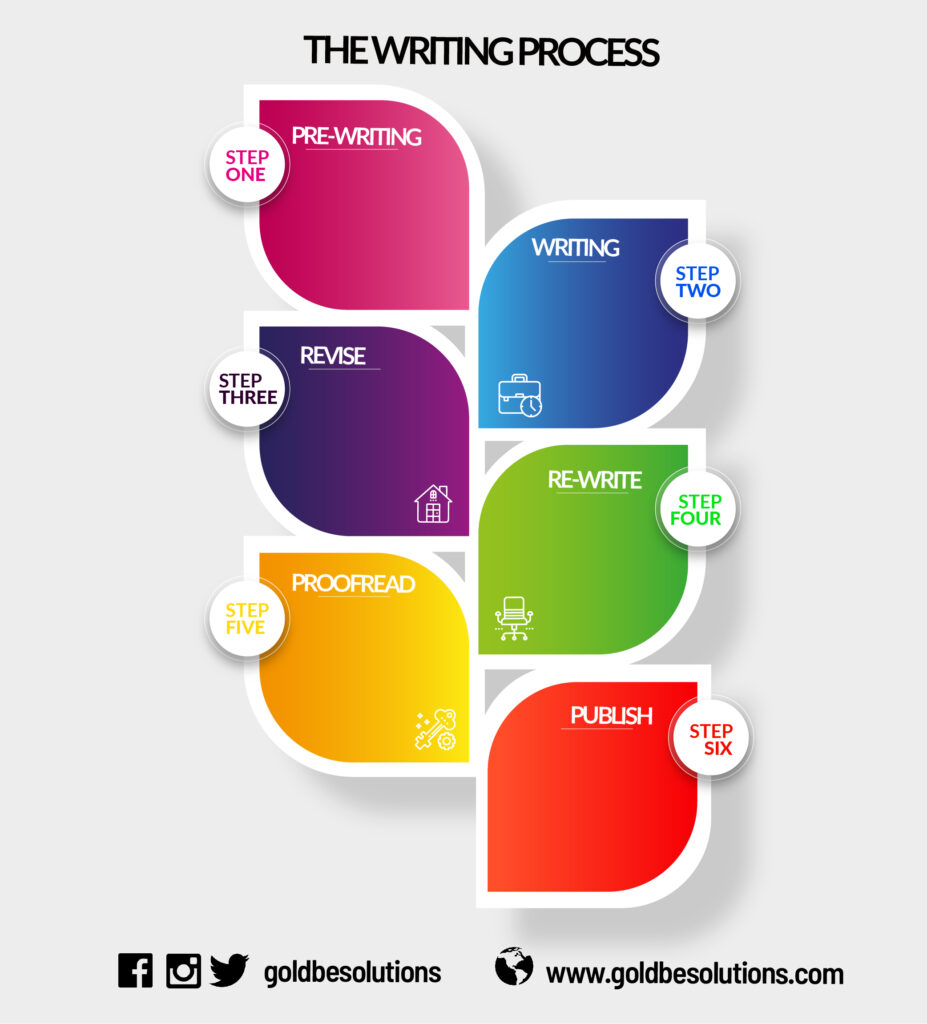Writing in many ways mirrors working on a project, and while many authors may not intentionally pay attention to this, most effective writing follows a standardised process. Below is a simple six-step process to guide your writing.

Step 1: The Pre-writing Stage
“Donald Graves … discovered that the best writers rehearsed what they were going to write before they began. I found this was also true of the best writers in newspapers. They had been writing the story in their head — and often in their reporter’s notebook — before they went out on their story, while they were reporting, and all the way back to their desks.”
— Donald M. Murray, Pulitzer Prize-winning Journalist, in Writing to Deadline
At the pre-writing stage, brainstorming, clustering, and freewriting are valuable tools writers can use to begin idea formation. This is the right stage to decide on the purpose of your text, the audience it is directed at, and the appropriate format and tone for that audience. To understand your audience, ask yourself these questions, “Who is going to read my paper?”, “What is the purpose of this paper?” and “Why are they going to read my paper?”
Make a habit of writing down the things that have captured your attention in the past week or month. For college students who write academic papers, this may mean engaging with your resource material and making notes to write the first draft.
In his masterclass, Neil Gaiman alludes to jotting down ideas as they come to him and letting them “rot on the heap of his imagination.” As a writer, you may or may not use them, but the benefits of having a repository of ideas far outweigh trying to produce the first draft without pre-writing.
Now, you can piece together ideas that form a coherent story or argument and create an outline.
Best Practice: Begin your writing process well ahead of the deadline, so you have ample time to mull over the incomplete ideas and turn them into fully-fledged ones for the next stage of the writing process.
Step 2: Writing/Drafting
“To become a proper writer, you have to forgive yourself the catastrophe of the first draft.” —Alain de Botton
Most of us are taught to edit and not to write. Right from grade school, we learn spelling, punctuation and other grammatical rules. While these are pillars of good writing and are worth mastering, a hyper emphasis on perfection can ruin a writer’s ability to freely put out the first draft. It is important to write down sentences even if they are not perfect. Don’t pay so much attention to mistakes during this stage.
During this stage, you should write based on the plausible ideas developed during the pre-writing stage.
Step 3: Revising
“In writing, you must kill all your darlings.”
― William Faulkner
This is a stage that requires more time and effort. When editing your draft, you must not just read but read well. Too often, proofreading is done when revision is needed. At this stage, you’ll look at language, formatting and style. Ensure that the tone is consistent throughout; look out for your use of the active and passive voices; look out for sentence fragments, good transitioning, overwritten or sloppy sentences. This is also a good stage to vet the consistency of your arguments, in the case of an academic paper, or of your characters, in creative text.
This stage will allow you to structure your arguments or story in such a way that it builds a rising arc.
Think of your revisions not as fixing your writing but as a way to improve your text. This perspective puts this gruelling stage in a positive light. Many professional writers confess that they put their texts through as many as eight (8) revisions. After you have done the first revision, reread what you have written. Pay attention to vocabulary, content and organisation of the details you need to change, move, add or remove.
Tip: Read your work aloud. Often our brains will autocorrect sentences when we read silently. It is difficult to revise your own work without assistance. Therefore, it is advisable to hand out your paper or manuscript to a good editor to point out any inconsistencies.
Step 4: Rewrite
At this stage, you need to ensure that every issue that was raised in the revision stage is rectified. Rewrite your draft and include the changes identified in the revision stage.
Step 5: Edit and Proofread
Remember the issue of perfection we addressed at the beginning of this post? Well, this is the point where that perfectionism will find a home: the editing stage. This is where you catch all the grammatical errors that slipped through the cracks during revisions or errors that were introduced after revision. At this stage, you need to correct spelling, capitalisation and punctuation, change words that are not used correctly or are unclear and make sure you use the appropriate formatting style. If you are writing an academic paper, ensure that your references are properly cited using the appropriate format for your field.
Editing is an extremely detailed process and is best done by a professional. Gold Business and Editing Solutions offers the best editing and proofreading services to ensure that your academic paper meets standards and your manuscript is error-free and ready to hit the market.
Step 6: Publishing
Finally, your masterpiece is ready to go out. Once you have gone through these six steps, you can sit back and enjoy the fruits of your labour and creativity.
